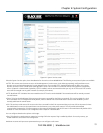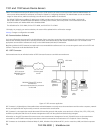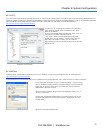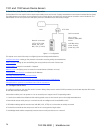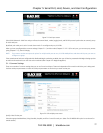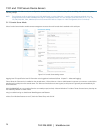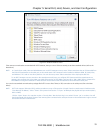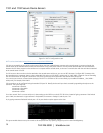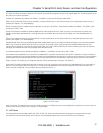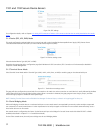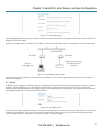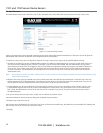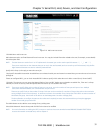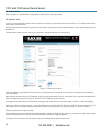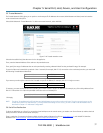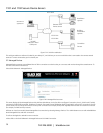
Chapter 5: Serial Port, Host, Device, and User Configuration
724-746-5500 | blackbox.com
31
TCP: RAW TCP allows connections directly to a TCP socket. Communications programs like PuTTY also support RAW TCP. You would usually access
this protocol via a custom application.
For RAW TCP, the default port address is IP Address _ Port (4000 + serial port #) for example, 4001–4002.
RAW TCP also enables the serial port to be tunneled to a remote console server, so two serial port devices can transparently interconnect over a
network (see Chapter 5.1.6—Serial Bridging).
RFC2217 Selecting RFC2217 enables serial port redirection on that port. For RFC2217, the default port address is IP Address _ Port (5000 + serial
port #), that is, 5001– 5002.
Special client software is available for Windows UNIX and Linux that supports RFC2217 virtual com ports, so a remote host can monitor and
manage remote serially attached devices, as though they were connected to the local serial port (see Chapter 5.6—Serial Port Redirection for
details).
RFC2217 also enables the serial port to be tunneled to a remote console server, so two serial port devices can transparently interconnect over a
network (see Chapter 5.1.6—Serial Bridging).
Unauthenticated Telnet: Selecting Unauthenticated Telnet enables telnet access to the serial port without requiring the user to provide credentials.
When a user accesses the console server to telnet to a serial port, he normally is given a login prompt. With unauthenticated telnet, the user
connects directly through to a port with any console server login. This mode is mainly used when you have an external system (such as conserver)
managing user authentication and access privileges at the serial device level.
For Unauthenticated Telnet, the default port address is IP Address _ Port (6000 + serial port #) i.e. 6001 – 6002.
Accumulation Period: By default, once a connection is established for a particular serial port (such as a RFC2217 redirection or Telnet connection to
a remote computer) then any incoming characters on that port are forwarded over the network on a character by character basis. The accumulation
period changes this by specifying a period of time that incoming characters will be collected before then being sent as a packet over the network.
Escape Character: This enables you to change the character used for sending escape characters. The default is ~.
Power Menu: This setting enables the shell power command. A user can control the power connection to a Managed Device from command line
when he is connected to the device via telnet or ssh. To operate, the Managed Device must be set up with both its Serial port connection and
Power connection configured. The command to bring up the power menu is ~p
Figure 5-8. PuTTY screen.
Single Connection: This setting limits the port to a single connection> If multiple users have access privileges for a particular port, only one user at a
time can access that port (that is, port “snooping” is not permitted).
5.1.3 SDT Mode
This setting allows port forwarding of RDP, VNC, HTPP, HTTPS, SSH, Telnet, and other LAN protocols through to computers that are locally
connected to the console server by their serial COM port. Port forwarding requires that you set up a PPP link over this serial port.



